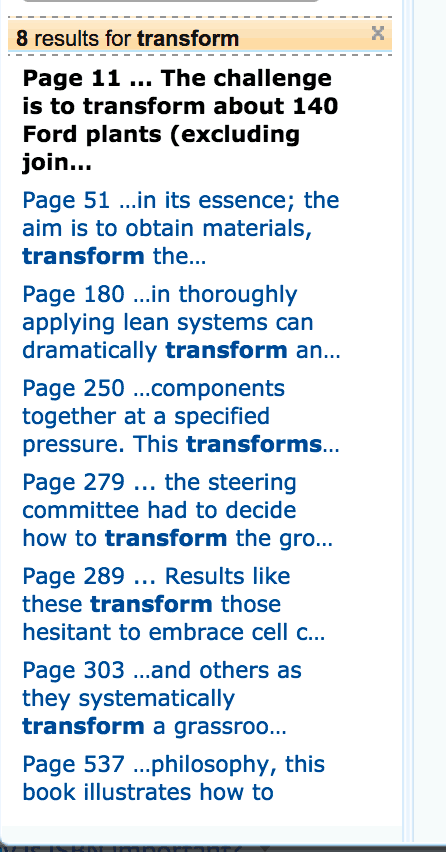I hear more people talking about how the word “implement,” as in the phrase “Lean implementation,” doesn't really create the right imagery, as an implementation suggests there is an end or that the implementation can be completed.
Hear Mark read this post (subscribe to the podcast):
The word implement (as a verb) means:
4. to fulfill; perform; carry out:
Once in office, he failed to implement his campaign promises.
5. to put into effect according to or by means of a definite plan or procedure.
I think “implement” implies an end… and the idea of a “definite plan” for a Lean implementation (a 5-year plan??) isn't very realistic or practical either. Sure, we need a Plan, but we also Do, Study, and Adjust.
The word “transformation” gets used quite a bit, as in the “Lean transformation” of an organization. I recently enjoyed the annual Lean Healthcare Transformation Summit this month, but it made me wonder “what are we transforming?“
Does a “transformation” also have an end point? Is that the right phrase to suggest “a journey of continuous improvement?”
“Transform” means:
1. to change in form, appearance, or structure; metamorphose.
2. to change in condition, nature, or character; convert.
3. to change into another substance; transmute.
I guess part of the question is “to what degree” we transform? I think it means a pretty dramatic change and reinvention.
A metamorphosis can be defined as:
“a profound change in form from one stage to the next in the life history of an organism, as from the caterpillar to the pupa and from the pupa to the adult butterfly.”
Does a Lean transformation for an organization, or a leader's transformation (as John Toussaint, MD has described about himself) mean something more like a metamorphosis, as from a caterpillar to a butterfly?

Should we be talking about “Lean Metamorphosis?”
Man, “Lean Transformation” sure is easier to spell.
One of the first books that I remember being about Lean as a business strategy (not just production tools) was Jeff Liker's book Becoming Lean: Inside Stories of U.S. Manufacturers, that was published just after the famed Lean Thinking from Womack and Jones. Womack wrote the foreword for Liker's book, actually.
Amazon reminds me I bought it in 1998:

The word “transformation” does get used within the book, eight times, including a reference to transforming Ford's plants. Those plants are still probably transforming themselves today. Continuous improvement and reinvention, right?

Lean Thinking also uses the word “transform,” including a reference to the personal transformation of Pat Lancaster, then CEO of Lantech, as they tried to transform the company (listen to my recent podcast with his son and current CEO Jim Lancaster):

As I blogged about this year, it's one thing to call yourself a “concrete head,” but I don't think it helps to throw that term at others.
What are some other books that call for “transformation” through Lean? They include some great books:
- Lean Transformation: How to Change Your Business into a Lean Enterprise (Bruce Henderson, 1999)
- Leading the Lean Enterprise Transformation (George Koenigsaecker, 2009)
- Andy & Me: Crisis & Transformation on the Lean Journey (Pascal Dennis, 2005)
- The Lean Manager: A Novel of Lean Transformation (Michael and Freddy Balle, 2009)
- The Toyota Way to Service Excellence: Lean Transformation in Service Organizations (Jeff Liker and Karyn Ross, 2016)
- Accelerating Health Care Transformation with Lean and Innovation: The Virginia Mason Experience (Paul Plsek, 2013)
The Lean methodology by no means has a monopoly on the word “transformation.” There are many books about “healthcare transformation.”
Isn't that the point? Healthcare transformation? Organizational transformation? That's the “end” (the goal, not the finish) — and Lean is just a means to that end, right?
That's the other thing that the phrase “Lean transformation” makes me think about… are we leading with the solution, if not jumping to the solution?
Would we engage more executives if we talked about “business transformation” or “organizational transformation?”
I know some hospitals, even, that label their “Lean department,” if you will, as the “Office of Business Transformation” or something similar to that. I could see people in a health system not liking the word “business,” though.
Maybe “Office of System Transformation” might resonate more? Or is it still too buzzwordy?
Maybe the words, whatever they are, aren't the bottleneck in the transformation or metamorphosis process?
What do you think? Please scroll down (or click) to post a comment. Or please share the post with your thoughts on LinkedIn – and follow me or connect with me there.
Did you like this post? Make sure you don't miss a post or podcast — Subscribe to get notified about posts via email daily or weekly.
Check out my latest book, The Mistakes That Make Us: Cultivating a Culture of Learning and Innovation:









Thought from Dan Jones:
I have come to see a fundamental difference in the worldview between the East and the West that I feel is a big hurdle to the success of lean in western organizations.
At its core, the East has historically viewed change as an organic process. Existing “parts” of a system divide and grow carrying within them their history and interdependence e.g. cells in an organism divide and grow.
The worldview of the West is mechanistic. Things are put together by the addition of parts that are essentially independent of each other e.g. bolt-on an AC system to add functionality to a car.
In such a context it’s not a surprise that western organizations would like to “implement” lean, whereas lean “grew” within Toyota.
Cheers,
Shrikant Kalegaonkar
Great point…
It depends what you mean by “engage.” Lots of execs would heartily approve of the need for “business transformation” or “organizational transformation” – and then delegate it to others to “implement.” I don’t think word choice is the point of engagement.
Metamorphosis? (from https://www.scientificamerican.com/article/caterpillar-butterfly-metamorphosis-explainer/): “But what does that radical transformation entail? How does a caterpillar rearrange itself into a butterfly? What happens inside a chrysalis or cocoon? First, the caterpillar digests itself, releasing enzymes to dissolve all of its tissues. If you were to cut open a cocoon or chrysalis at just the right time, caterpillar soup would ooze out.”
Obviously, then, the first step for executive metamorphosis is for the executive to digest itself; meaning, to digest one’s brain – the “mental revolution” that Frederick Winslow Taylor and Taiichi Ohno both insisted upon. It means changing one’s beliefs as the starting point of metamorphosis from conventional leader to Lean leader.
Unfortunately, the problem remains the same despite changes in the words used to describe it.
By the way, Ohno used the word “implement” in his book, Toyota Production System. I think it simply means to “make the necessary changes to establish basic TPS” and then continue to evolve TPS as times and circumstances change.
Yes, Ohno (or Bodek’s translator) wrote:
“Superficial understanding” is indeed a big problem out there in healthcare. In other industries too, I bet.
Shrikant made a great comment about having a mechanistic approach in the west. I tend to agree with him. There is an endpoint with the word transform, but that endpoint is the start of a new beginning. Such is the case with a caterpillar into a butterfly.
A book I like on the subject is The Lean Turnaround. According to the search on Safari books online the word “transform” appears 43 times. It’s even in the subtitle. How Business Leaders Use Lean Principles to Create Value and Transform Their company. The action guide has the word 7 times.
Hi All,
Yes, there’s a great deal of overlap between the terms “transformation” and “metamorphosis.” In fact, the word metamorphosis appears as a secondary definition for the word transformation, implying a significant/dramatic change in state or condition. However, based on common usage, the word “metamorphosis” tends to carry more of a biological orientation. Yet, most importantly, both tend to emphasize a SYSTEMIC level of change involving all the elements/components that make up or comprise the SYSTEM.
From a business perspective, it would make sense – to me – to stick with the term transformation and refer to the biological process of metamorphosis as a good analog for what has to take place in order for a major transformation/reengineering initiative/endeavor to be successful on a SYSTEMIC level. And beyond ramifications associated with that dramatic first reevolutionary step, I believe that the word transformation leaves the door open to the on-going process of continuous improvement and continuous adaptation. Where the biological process of metamorphosis is governed by a predetermined (i.e., genetically defined) end-state, the process of transformation tends to lend itself to an on-going, adaptive, evolutionary process; one that is dictated in large measure by the prevailing conditions in an organizations chosen operating environment(s). And the outcome of a transformation initiative is more aptly governed by discretionary and adaptive human intention; in other words, by freedom of choice.
Ergo, in the process of metamorphosis, it’s Mother Nature that creates the ENVIRONMENT (inside a chrysalis for example) necessary for the change in morphological state to occur. In contrast, in the process of transformation, it’s senior level management that is responsible for creating an ENVIRONMENT that’s most conducive to the sort of THINKING AND BEHAVING that’s needed to achieve levels of all-around performance that are comparable – if not superior – to those of Toyota (as the present day gold-standard for sustainable superior business performance within a particular industry).